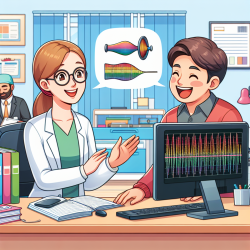Speech-language pathologists (SLPs) continually seek innovative methods to enhance their practice and provide exceptional care to their clients. One area ripe with potential for enriching speech therapy practice is the application of findings from clinical spectrography research. By delving into the intricate processes that underlie speech production, practitioners can refine their therapeutic approaches, leading to more targeted and effective interventions.
Understanding Clinical Spectrography
Clinical spectrography offers a window into the acoustic properties of speech sounds, allowing for a detailed analysis of speech production. Through spectrographic analysis, SLPs can visualize the frequency, intensity, and duration of phonemes produced by clients. This insight is invaluable for identifying subtle speech production errors that may not be easily detected through auditory analysis alone.
Implementing Research Findings
The research article titled "Readings in Clinical Spectrography of Speech" presents a comprehensive overview of the evolution and application of speech spectrographic analysis. By integrating the outcomes of this research into practice, SLPs can enhance their diagnostic precision and tailor their therapeutic interventions more effectively. For instance, the ability to identify specific phonetic or phonological issues through spectrographic analysis enables clinicians to focus their therapy on the underlying speech production mechanisms.
Encouraging Further Research
While the application of clinical spectrography in speech therapy is promising, it is also a field that benefits greatly from ongoing research. As SLPs begin to incorporate spectrographic analysis into their practice, they are also uniquely positioned to contribute to the body of knowledge in this area. By documenting their findings and sharing insights, practitioners can help refine existing methodologies and explore new applications of spectrography in speech therapy.
Practical Applications in Therapy
There are several practical ways in which SLPs can apply findings from clinical spectrography research to enhance therapy outcomes:
- Articulation Disorders: Spectrographic analysis can help in identifying and distinguishing between similar speech sounds, aiding in the diagnosis and treatment of articulation disorders.
- Fluency Disorders: By analyzing the temporal patterns of speech, SLPs can gain insights into the characteristics of fluency disorders, such as stuttering, and develop more effective intervention strategies.
- Voice Disorders: Spectrography can reveal abnormalities in voice quality, pitch, and loudness, supporting the assessment and treatment of voice disorders.
- Accent Modification: For clients seeking accent modification, spectrographic analysis can provide objective feedback on their production of target sounds, facilitating more efficient therapy.
Professional Development and Collaboration
For SLPs interested in integrating clinical spectrography into their practice, professional development opportunities such as workshops, webinars, and conferences are invaluable. These forums not only offer training in the use of spectrographic analysis tools but also foster collaboration among practitioners, researchers, and educators. Networking within these professional circles can lead to shared resources, joint research projects, and the exchange of clinical insights, further advancing the field.
Conclusion
The integration of clinical spectrography research findings into speech therapy practice offers a promising avenue for enhancing therapeutic outcomes. By leveraging the detailed insights provided by spectrographic analysis, SLPs can improve their diagnostic accuracy and develop more targeted interventions. Furthermore, by engaging in ongoing research and professional development, practitioners can contribute to the advancement of this field, ultimately benefiting the clients they serve. For those interested in exploring this topic further, the original research paper provides a wealth of information and can be accessed through the following link: Readings in Clinical Spectrography of Speech.










